Names link to more information
on identification and management.
Click on photos to enlarge
| Caterpillar damage |
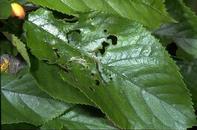
Fruittree leafroller damage
Identification tip: Larvae feed on leaves, often webbing
them together; fruit feeding (not shown) is usually shallow.
|
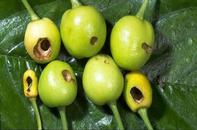
Green fruitworm damage
Identification
tip: Green fruitworm may chew deep holes in green fruit.
|
| Other invertebrates |
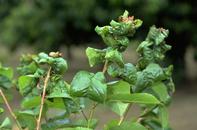
Black cherry aphid damage
Identification
tip: Feeding causes curling and distortion of leaves.
|
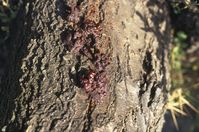
Peachtree borer
damage
Identification tip: Gum mixed with frass can be found
around the base of trees with an active peachtree borer infestation.
|
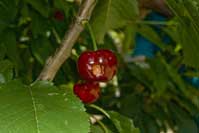
European earwig
Identification tip: Feeding damage on fruit
results in shallow, irregular holes.
|
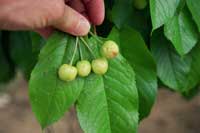
Western
flower thrips damage
Identification tip: Egg laying by thrips causes
dimples on the surface of green fruit.
|
| Diseases |
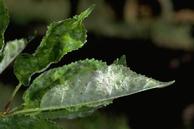
Powdery mildew damage
Identification
tip: Powdery mildew appears as whitish fungal growth
on leaves; leaves may become distorted.
|
No photo available.
Brown rot fruit
damage
Identification tip: Fruit damage first appears as
small, dark spots on the fruit surface. Dark brown discoloration
spreads rapidly; grayish brown tufts of spores develop
on the surface of the rotted area. |
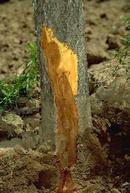
Phytophthora root and crown
rot
damage
Identification tip: The wood of a Phytophthora canker
is dark, reddish brown, often with a zonate margin.
|
No photo available.
Botrytis damage
Identification tip: Brown decay develops on fruit,
and light brown or gray spores cover the surface. Infected
fruit become watery and soft. |
| Vertebrates |
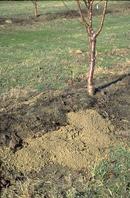
Gopher damage
Identification
tip: Gophers form conspicuous mounds of dirt on the orchard
floor. Burrow openings are plugged with soil.
|
|


